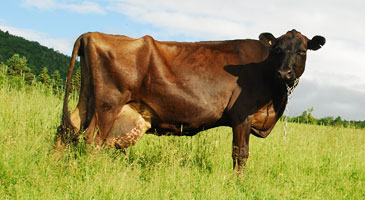Type the name of the breed you're looking for below
[wpdreams_ajaxsearchlite] Don't see the breed your're looking for? Click here and let us know!
Canadienne cattle
| Place of Origin | Canada |
| Origin | The Canadienne Breed can be traced back to cattle in present day Quebec that came from Normandy and Brittany regions of France in the 1600s. The breeds that came in are unknown; the melting pot effect took over until the breed took on its own appearance and type. It is believed that Canadienne cattle come from the same general ancestry as Guernsey, Jersey and Kerry cattle. They developed into a hardy, compact dairy breed that could survive the harsh environment of Quebec. The cattle also provided draught work and meat, important for the colonization. In 1850, the Canadian Parliament discovered that the vast majority of cattle in Quebec were Canadienne, so they began to discourage its breeding and soon the breed received competition from other breeds. In 1886, a couple men created a herd book and then French Canadian Cattle Breeder's Association was formed in 1895 to prevent the breed from becoming extinct. The breed later gained recognition in 1901 for being the most profitable dairy breed in the Pan-American show in Buffalo, New York. In the early 1970s the Ministry of Agriculture became concerned about the amount of inbreeding occurring with the Canadienne breed and the lack of improvement in milk production, so they introduced Brown Swiss genetics. The use of Brown Swiss genetics was uncontrolled and had to be stopped to preserve the purity of Canadienne cattle. In 1999, the Canadienne cow was given official heritage status by the Government of Quebec and its breeding program is supported to preserve the breed. |
| Purpose | The main use of Canadienne cattle is for milk production, but they have also been used for meat consumption and draught work. They produce economically profitable milk in difficult conditions. Their hardiness and quiet nature made them good animals to use for farm work. |
| Appearance | The Canadienne breed has been developed to be small and compact to survive the harsh Canadian environment. They usually have dark brown or black coats with lighter coloured muzzle, topline and udder/scrotum. |
| Horns | If horns are present, they will be long and upturned with darker coloured tips. Otherwise they are polled (hornless). |
| Cows Average Weight | 454 - 499 kg (1,000 - 1,100 lbs.) |
| Other Considerations | The Canadienne, though still found on farms and ranches across the nation, is now comparatively rare except in certain portions of Quebec Province. Efforts by an active breed society and the Quebec government have been made in recent years to preserve the breed from extinction. |



